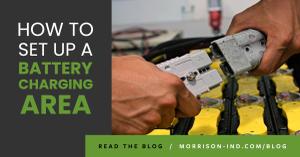
Battery charging areas or rooms have certain requirements and the location can help or hinder traffic flow and productivity.
Home » Morrison Minutes » Search

Battery charging areas or rooms have certain requirements and the location can help or hinder traffic flow and productivity.

The forks on your forklift may seem like a minor detail, but they play a significant role in the overall performance of your equipment.

Forklift chains, powered by hydraulic pressure, handle massive weight every day. These chains are critical to your forklift’s performance and safety, so regular inspection is essential to prevent excessive wear or failure.

Fleet management refers to the collection, analysis and use of critical equipment data to improve productivity and reduce costs. Fleet management programs, such as Morrison's free Maintenance Logistics:MX online program, keep a fleet running efficiently, on time, and within budget.

Just as athletes rely on the right gear for peak performance, or an artist the right brushes, equipping your lift truck with proper tires is crucial for the longevity and efficiency of your equipment.

Here are some maintenance guidelines to keep your electric forklift's lead acid batteries performing and lasting as they should.

Forklifts are important machines that help move things in warehouses and other places. They can run on either batteries or fuels like LPG or diesel. In this blog post, we will learn how to safely recharge or refuel a forklift.

Lithium-ion (Li-ion) batteries are creating a fundamental change in the material handling industry. The longer runtimes, longer lifespan, fast charge capability, and reduced cost of ownership make adoption of lithium-ion power a clear decision.

Does that headline scare you? Well, it should if you rely on electric forklifts. Yikes!

It’s simple. When you invest in a piece of equipment, you want it to perform. With a floor scrubber or sweeper/scrubber that means clean, dry floors. No unsightly streaks. No dirt left behind. No wet patches that could cause slips or falls.

Downtime is a dirty word. We hate it. YOU, hate it. It is more than an “inconvenience”—it is expensive. Let’s discuss how you can avoid downtime as much as possible and keep your business—and your forklifts—moving forward.

In this article we compare forklift battery types by looking at power and energy, charging, maintenance, safety and more.